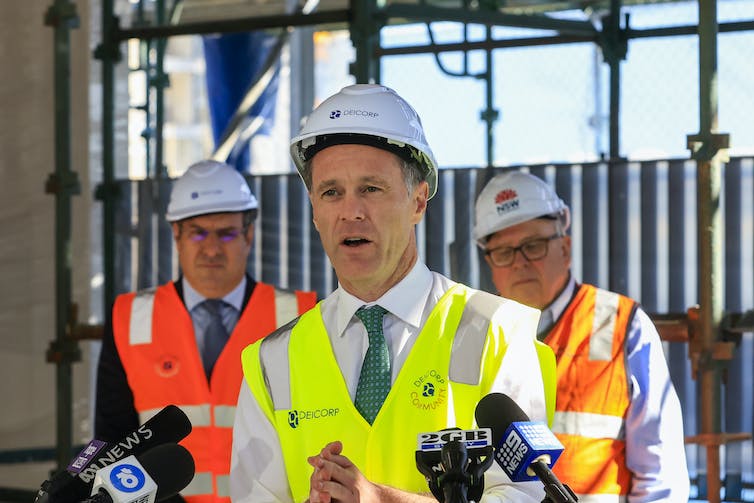Some of the largest landowners across New South Wales are Local Aboriginal Land Councils. Given the acute needs for housing and infrastructure, it’s time the state government enabled these land councils to play a greater role in development.
According to the Greater Cities Commission’s outgoing chief commissioner, Geoff Roberts, Local Aboriginal Land Councils (LALC) are the largest landowners in three of the region’s six cities from Newcastle in the north to Wollongong in the south.
Roberts told me the commission’s strategic plans simply cannot be carried out without embedding in them Aboriginal values and perspectives. “We cannot move forward, without going back.” And by back, he meant returning to where it all began with European invasion.
In April, the commission set up the First Nations Advisory Panel to “help identify strategic issues in the planning system that work against First Nations people’s aspirations and […] provide advice regarding system-level change to address these challenges”.
Government can learn a lot from the commission’s approach. Recognition is growing within the state government that good development – for housing and commercial purposes, in transport, or within cultural precincts – requires reckoning with the past by partnering with Indigenous communities to deliver the future city. This has led to policies such as the Connecting with Country Framework and the Aboriginal Land State Environmental Planning Policy.
Yet good intentions have been slow to deliver results.
I have been researching the work and policy environment of Local Aboriginal Land Councils since 2020 and found they face three kinds of planning and development roadblocks in Greater Sydney: legal and bureaucratic, political, and relational.
How can Aboriginal communities be part of the NSW renewable energy transition?
Legal and bureaucratic challenges
Aboriginal land councils are member-based organisations established under the Aboriginal Land Rights Act 1983 (NSW). Membership is open to all adult Aboriginal people in each council’s area.
These councils have the right to claim Crown land that is not lawfully used or occupied, or needed for an essential public purpose, among other things.
Land councils can sell, lease and/or develop the claimed land, and are bound by planning laws and regulations like any other landowner. However, land councils are different since they own land acquired through a compensatory framework to redress severe historical dispossession.
In practice, NSW’s 120 Local Aboriginal Land Councils face mounting difficulties, both in claiming land and in planning, developing and using their land to benefit their communities and the public.
A 2021 review found long delays in determining land claims across NSW. Over 38,000 claims awaited the minister’s determination – roughly 70% of the total made in the 40 years since the law took effect. Around 60% were five or more years old.
At the current rate, it will take 22 years to determine existing claims. And land under claim cannot be developed.
In NSW there have been significant wins for First Nations land rights. But unprocessed claims still outnumber the successes
Land councils also find it incredibly difficult to activate successfully claimed land. Typically, it’s disused Crown land on the fringes of suburbs and towns.
At times, this land is downzoned as “conservation” after its transfer to the land council. Land councils must then prepare expensive planning proposals to rezone the land as residential, straining their limited resources.
Recognising these difficulties, in 2019 the NSW government introduced a policy permitting land councils to submit development delivery plans for approval by the planning minister. These measures are designed to approach Aboriginal land development strategically and holistically, rather than in a piecemeal way. Their long-term impact is yet to be seen.
Political challenges
Some are unhappy with the “special treatment” of land councils and with their development agenda. Sometimes objections to development come from Traditional Owners and Custodians of the land.
This is partly due to the distinction observed by historian Heidi Norman that emerged between “Aboriginal owners” and “land council members” following the Commonwealth Native Title Act 1993. In my interviews, policymakers and bureaucrats have expressed confusion about adhering to cultural protocols while also dealing fairly and professionally with Aboriginal landowners.
But more often it’s non-Indigenous residents who oppose Aboriginal land development. One example, reported as an “Aboriginal land rights test case”, involves a proposed development in Belrose in Sydney’s Northern Beaches.
Local MPs, residents and councillors have opposed the plan to develop 71 hectares of bushland as a 450-lot subdivision. They cite environmental reasons, pressures on infrastructure and fire risks. First submitted to the Department of Planning in 2014, the plan became a state election issue this year.
A revised proposal gained a so-called “Gateway” preliminary approval last month. Opposition is bound to continue through the long approval process.
Relational challenges
Many land councils are land-rich, but most are cash-poor. They are understandably reluctant to sell land. This means they have to find partners to realise their development plans.
The main model for land council developments is joint ventures with private or state-owned developers. Co-design and co-management of projects requires partnerships built on strong relationships. Despite a willingness to engage, both government and industry often lack understanding of the issues land councils face. As a senior planning department official told me:
That conversation and engagement to understand how you put that cultural overlay and the trauma and the healing into the [planning] strategy […] that is a long, ongoing conversation. And you can’t force it. It has to be organic, and it has to be [based] on trust and rapport. But no government workflow or business case [operates on that timeline].
Due to this misalignment of approaches and frequent public sector personnel changes, the conditions for meaningful collaboration are rarely met.
Indigenous communities are reworking urban planning, but planners need to accept their history
Land councils can be development allies
NSW Premier Chris Minns recently announced incentives for large developers to build higher, denser housing in Sydney. “State significant developments” will be fast-tracked, bypassing local councils and planning panels.
Jenny Evans/AAP
Land councils own large areas of land in areas of immense need. Unlike profit-driven developers, they champion social and economic justice. Yet land councils still face major barriers to development.
What if the government considered land councils as allies in the struggle to meet housing and other needs? Development that properly considers where and how to build and for whose benefit would be better for both Indigenous communities and the rest of the public.




